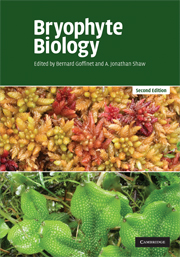Book contents
- Frontmatter
- Contents
- List of contributors
- Preface
- 1 Morphology and classification of the Marchantiophyta
- 2 Morphology, anatomy, and classification of the Bryophyta
- 3 New insights into morphology, anatomy, and systematics of hornworts
- 4 Phylogenomics and early land plant evolution
- 5 Mosses as model organisms for developmental, cellular, and molecular biology
- 6 Physiological ecology
- 7 Biochemical and molecular mechanisms of desiccation tolerance in bryophytes
- 8 Mineral nutrition and substratum ecology
- 9 The structure and function of bryophyte-dominated peatlands
- 10 Population and community ecology of bryophytes
- 11 Bryophyte species and speciation
- 12 Conservation biology of bryophytes
- Index
- References
7 - Biochemical and molecular mechanisms of desiccation tolerance in bryophytes
Published online by Cambridge University Press: 06 July 2010
- Frontmatter
- Contents
- List of contributors
- Preface
- 1 Morphology and classification of the Marchantiophyta
- 2 Morphology, anatomy, and classification of the Bryophyta
- 3 New insights into morphology, anatomy, and systematics of hornworts
- 4 Phylogenomics and early land plant evolution
- 5 Mosses as model organisms for developmental, cellular, and molecular biology
- 6 Physiological ecology
- 7 Biochemical and molecular mechanisms of desiccation tolerance in bryophytes
- 8 Mineral nutrition and substratum ecology
- 9 The structure and function of bryophyte-dominated peatlands
- 10 Population and community ecology of bryophytes
- 11 Bryophyte species and speciation
- 12 Conservation biology of bryophytes
- Index
- References
Summary
Introduction
Bryophytes, because they descend from the earliest branching events in the phylogeny of land plants, hold an important position in our investigations into the mechanisms by which plants respond to dehydration and by what paths such mechanisms have evolved. This is true regardless of what aspect of plant responses to dehydration one is interested in; whether it be mild water deficit stress as seen in most plants including those of agronomic importance, or desiccation as seen in orthodox seeds or in the leaves of desiccation-tolerant (or resurrection) plants. It is quite possible that the mechanisms by which bryophytes tolerate dehydration closely reflect the way that the first land plants coped with the rigors of a drying atmosphere as they began their colonization of the land. In a recent phylogenetic synthesis of the evolution of desiccation tolerance within the land plants (Oliver et al. 2000), it was postulated that vegetative desiccation tolerance was required for plants to transition from an aqueous environment to the dry land. In the initial ventures into dehydrating atmospheres, plants were of a very simple architecture and had yet to evolve the complex strategies to prevent water loss that we see in modern day plants. Once the cells of these plants were no longer surrounded by liquid water they would rapidly lose water and dry.
- Type
- Chapter
- Information
- Bryophyte Biology , pp. 269 - 298Publisher: Cambridge University PressPrint publication year: 2008
References
- 10
- Cited by



